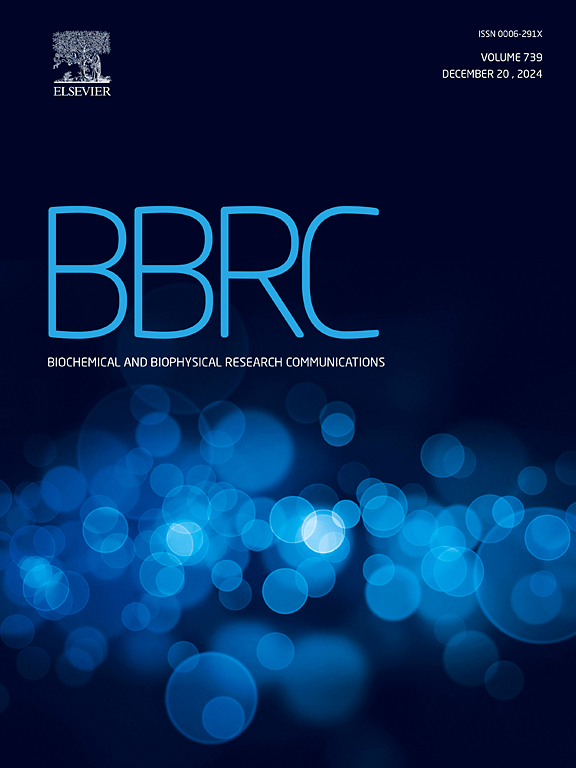地黄苷A通过AT1R/MAPK14/IL-17信号通路缓解高血压肾病肾炎症和纤维化
IF 2.2
3区 生物学
Q3 BIOCHEMISTRY & MOLECULAR BIOLOGY
Biochemical and biophysical research communications
Pub Date : 2025-06-19
DOI:10.1016/j.bbrc.2025.152237
引用次数: 0
摘要
本研究旨在观察地黄苷A (ReA)在高血压肾病(HN)中的作用及其可能机制。方法采用血管紧张素II (angii)构建小鼠和大鼠肾小管上皮细胞shn模型。评估肾功能的生物标志物,包括尿酸(UA)、肌酐(Cre)、血尿素氮(BUN)和尿白蛋白。结果II可引起严重的肾损伤,而ReA可减轻肾损伤。在angii诱导的高血压小鼠模型中,ReA降低UA、Cre、BUN、尿白蛋白、转化生长因子(TGF)-β、纤维连接蛋白、胶原I、白细胞介素(IL)-6、IL-1β和肿瘤坏死因子(TNF)-α的水平。在angii处理的细胞中,ReA降低TGF-β、纤维连接蛋白、I型胶原、IL-6、IL-1β和TNF-α的水平。在体内和体外实验中,ReA促进血管紧张素转换酶2 (ACE2)的表达,抑制HN模型中血管紧张素II型1受体(AT1R)、ACE、IL-17、丝裂原活化蛋白激酶14 (MAPK14)、磷酸化(p)-MAPK14、p - nf -κB P65、基质金属肽酶9 (MMP-9)的表达。此外,ReA与MAPK14蛋白存在对接,ReA通过促进MAPK14泛素化抑制MAPK14蛋白的表达。在Ang II处理下,MAPK14过表达逆转了ReA对细胞活力的促进作用和ReA对NRK-52E细胞纤维化和炎症的抑制作用。结论rea减轻肾功能障碍,减轻纤维化和炎症,其作用与抑制AT1R/MAPK14/IL-17通路有关。对于HN治疗,ReA可能是一种很有前途的药理学策略。本文章由计算机程序翻译,如有差异,请以英文原文为准。
Rehmannioside A alleviates renal inflammation and fibrosis in hypertensive nephropathy via AT1R/MAPK14/IL-17 signaling pathway
Background
This study aimed to observe the influences and potential mechanism of rehmannioside A (ReA) in hypertensive nephropathy (HN).
Methods
HN model in mice and rat tubular epithelial cells were constructed by angiotensin II (Ang II). The biomarkers of renal function, including uric acid (UA), creatinine (Cre), blood urea nitrogen (BUN), and urine albumin, were assessed.
Results
Ang II induced severe kidney injury, while the injury was ameliorated by ReA. In Ang II-induced hypertensive mice model, ReA decreased the levels of UA, Cre, BUN, urine albumin, transforming growth factor (TGF)-β, Fibronectin, Collagen I, interleukin (IL)-6, IL-1β, and tumour necrosis factor (TNF)-α. In Ang II-treated cells, ReA reduced the levels of TGF-β, Fibronectin, Col1agen I, IL-6, IL-1β, and TNF-α. In vivo and in vitro, ReA promoted angiotensin converting enzyme 2 (ACE2) expression and inhibited the expression of angiotensin II type 1 receptor (AT1R), ACE, IL-17, mitogen activated protein kinase 14 (MAPK14), phosphorylated (p)-MAPK14, p–NF–κB P65, and matrix metallopeptidase 9 (MMP-9) in HN model. Moreover, there was a docking for ReA and MAPK14 protein, and ReA inhibited MAPK14 protein expression by promoting MAPK14 ubiquitination. Under Ang II treatment, MAPK14 overexpression reversed the promotive effect of ReA on cell viability and the inhibitory effects of ReA on fibrosis and inflammation in NRK-52E cells.
Conclusions
ReA alleviated renal dysfunction and reduced fibrosis and inflammation, which was related to the inhibition of AT1R/MAPK14/IL-17 pathway. For HN treatment, ReA may be a promising pharmacological strategy.
求助全文
通过发布文献求助,成功后即可免费获取论文全文。
去求助
来源期刊
CiteScore
6.10
自引率
0.00%
发文量
1400
审稿时长
14 days
期刊介绍:
Biochemical and Biophysical Research Communications is the premier international journal devoted to the very rapid dissemination of timely and significant experimental results in diverse fields of biological research. The development of the "Breakthroughs and Views" section brings the minireview format to the journal, and issues often contain collections of special interest manuscripts. BBRC is published weekly (52 issues/year).Research Areas now include: Biochemistry; biophysics; cell biology; developmental biology; immunology
; molecular biology; neurobiology; plant biology and proteomics

 求助内容:
求助内容: 应助结果提醒方式:
应助结果提醒方式:


